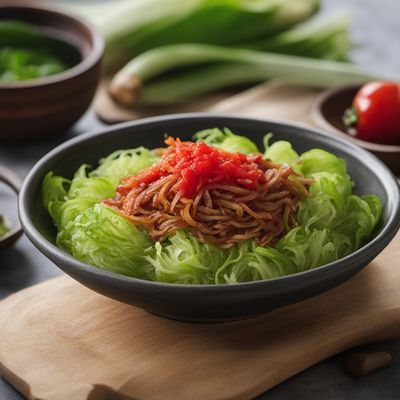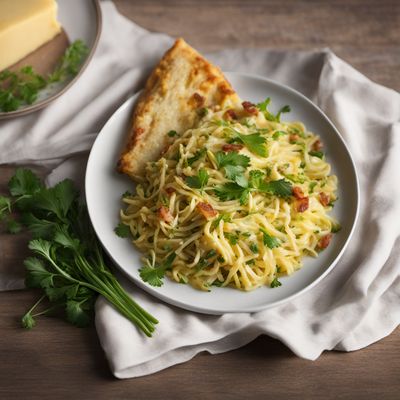
Recipe
Paradeiskraut with Semmelknödel (Tomato Cabbage with Bread Dumplings)
Savory Tomato Cabbage Delight with Fluffy Bread Dumplings
4.3 out of 5
Indulge in the flavors of Austrian cuisine with this delightful Paradeiskraut recipe. A combination of tangy tomatoes and tender cabbage, served alongside soft and flavorful bread dumplings, this dish is a true representation of Austrian comfort food.
Metadata
Preparation time
30 minutes
Cooking time
45 minutes
Total time
1 hour 15 minutes
Yields
4 servings
Preparation difficulty
Medium
Suitable for
Vegetarian, Vegan (if omitting eggs and using plant-based milk), Dairy-free (if using plant-based milk), Nut-free, Low calorie
Allergens
Wheat (in the bread dumplings), Eggs, Milk
Not suitable for
Gluten-free (due to the bread dumplings)
Ingredients
-
1 medium cabbage, shredded (500g) 1 medium cabbage, shredded (500g)
-
1 onion, finely chopped 1 onion, finely chopped
-
2 cloves of garlic, minced 2 cloves of garlic, minced
-
4 tomatoes, diced 4 tomatoes, diced
-
2 tablespoons tomato paste 2 tablespoons tomato paste
-
1 tablespoon olive oil 1 tablespoon olive oil
-
1 teaspoon paprika 1 teaspoon paprika
-
1 teaspoon caraway seeds 1 teaspoon caraway seeds
-
Salt and pepper to taste Salt and pepper to taste
-
4 cups (950ml) vegetable broth 4 cups (950ml) vegetable broth
-
4 cups (200g) stale bread, cubed 4 cups (200g) stale bread, cubed
-
1 cup (240ml) milk 1 cup (240ml) milk
-
2 eggs 2 eggs
-
2 tablespoons fresh parsley, chopped 2 tablespoons fresh parsley, chopped
Nutrition
- Calories (kcal / KJ): 320 kcal / 1340 KJ
- Fat (total, saturated): 7g, 1g
- Carbohydrates (total, sugars): 55g, 15g
- Protein: 12g
- Fiber: 10g
- Salt: 2g
Preparation
-
1.In a large pot, heat the olive oil over medium heat. Add the onions and garlic, and sauté until translucent.
-
2.Add the shredded cabbage to the pot and cook for 5 minutes, stirring occasionally.
-
3.Stir in the diced tomatoes, tomato paste, paprika, caraway seeds, salt, and pepper. Cook for another 5 minutes.
-
4.Pour in the vegetable broth and bring to a boil. Reduce the heat to low, cover the pot, and simmer for 30 minutes, or until the cabbage is tender.
-
5.While the cabbage is simmering, prepare the bread dumplings. In a bowl, combine the stale bread cubes, milk, eggs, and chopped parsley. Mix well until the bread absorbs the liquid and becomes soft.
-
6.Shape the bread mixture into small dumplings, about the size of a golf ball.
-
7.Bring a large pot of salted water to a boil. Gently drop the dumplings into the boiling water and cook for about 10 minutes, or until they float to the surface.
-
8.Remove the dumplings from the water using a slotted spoon and serve alongside the Paradeiskraut.
Treat your ingredients with care...
- Stale bread — It's important to use stale bread for the dumplings as it absorbs the liquid better and results in a softer texture.
- Cabbage — Make sure to shred the cabbage finely for even cooking and texture.
Tips & Tricks
- To add a smoky flavor, you can sprinkle some smoked paprika over the Paradeiskraut before serving.
- If you prefer a spicier dish, add a pinch of chili flakes to the tomato cabbage.
- For a richer flavor, you can use vegetable broth instead of water when cooking the cabbage.
Serving advice
Serve the Paradeiskraut with Semmelknödel as a main course, accompanied by a fresh green salad or pickled vegetables.
Presentation advice
Garnish the dish with a sprinkle of fresh parsley or a drizzle of olive oil for an appetizing presentation.
More recipes...
For Paradeiskraut
More Austrian cuisine dishes » Browse all

Salzburger Nockerl
Salzburg Dumplings
Salzburger Nockerl is a traditional Austrian dessert made with egg whites, sugar, and vanilla. It has a light, fluffy texture and a sweet, delicate flavor.

Tiroler Gröstl
Tiroler Gröstl is a traditional dish from the Austrian region of Tyrol.

Bauernschmaus
Farmer's Feast
Bauernschmaus is a traditional Austrian dish that is hearty and filling. It is perfect for cold winter nights or as a comfort food.






